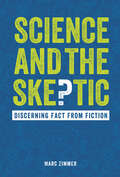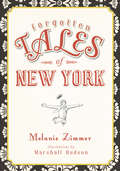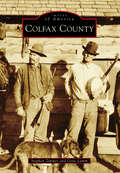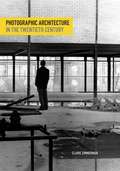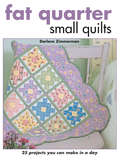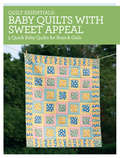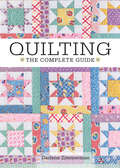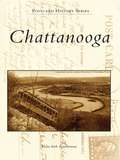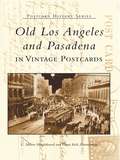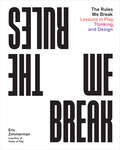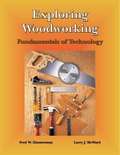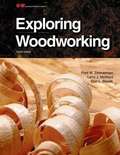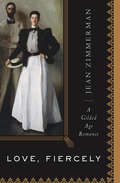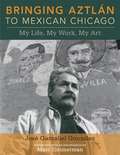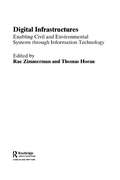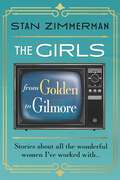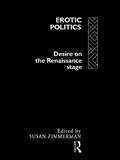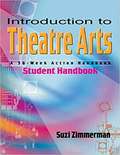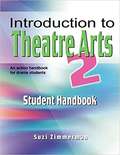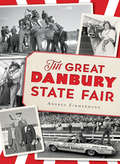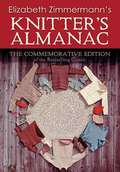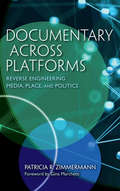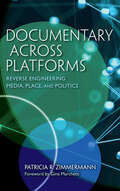- Table View
- List View
Science and the Skeptic: Discerning Fact from Fiction
by Marc ZimmerFake news, pseudoscience, and quackery have become scourges, spreading through society from social media all the way to Congress. The line between entertainment and reality, between fact and fiction, has become blurred. Some of the most crucial issues of our time—climate change, vaccines, and genetically modified organisms—have become prime targets for nefarious disinformation campaigns. Far too many people have become distrustful of real science. Even those who still trust science no longer know what to believe or how to identify the truth. Not only does this result in the devaluation and distrust of real science, but it is also dangerous: people acting based on false information can hurt themselves or those around them. We must equip ourselves with the knowledge and skills to fight back against all this disinformation. InScience and the Skeptic: Discerning Fact from Fiction, you will learn how science is done, from the basic scientific method to the vetting process that scientific papers must go through to become published; how and why some people intentionally or unintentionally spread misinformation; and the dangers in believing and spreading false information. You'll also find twenty easy-to-follow rules for distinguishing fake science from the real deal. Armed with this book, empower yourself with knowledge, learning what information to trust and what to dismiss as deceit. "We're not just fighting an epidemic; we're fighting an infodemic. . . . This is a time for facts, not fear. This is a time for rationality, not rumors. This is a time for solidarity, not stigma."—Tedros Adhanom Ghebreyesus, director-general of the WHO "Our deepest beliefs should help navigate reality, not determine it."—Michael Gersen, The Washington Post "Journalism is very much about trying to simplify and distribute information about what's new and where advances have been made. That's incompatible with the scientific process, which can take a long time to build a body of evidence."—Kelly McBride, Poynter Institute
Forgotten Tales of New York (Forgotten Tales Ser.)
by Melanie ZimmerLearn the Empire State&’s little known history—from bone-stealing dogs to the world&’s largest puzzle—by the author of Curiosities of the Finger Lakes. Few New Yorkers remember the night when firemen, in tuxedos and top hats, were dragged from a ball to extinguish a Waterloo blaze, or the typographical error that reported Theodore Roosevelt taking a &“bath&” instead of his presidential &“oath.&” Still fewer remember Cephas Bennett, a missionary from Utica and printer of the first Burmese Bible, or H. L. Mencken&’s humorous article on the history of the bathtub, still quoted today as factual although entirely invented. Seasoned storyteller Melanie Zimmer seamlessly weaves together these hard-to-believe, yet entirely true, tales. From the monster of Seneca Lake to the man who inspired the American icon Uncle Sam, discover the lost secrets of the Empire State. Includes photos!
Colfax County
by Stephen Zimmer Gene LammIn 1841, Carlos Beaubien and Guadalupe Miranda received a grant of land from the governor of New Mexico in the northeastern part of the Mexican province. Frontier conditions prevented colonization of the grant until 1848, when Beaubien's son-in-law Lucien Maxwell led settlers from Taos to the Rayado River where it crossed the Santa Fe Trail. Maxwell's friend Kit Carson joined him the following year, and their ranch prospered in spite of frequent attacks by Jicarilla Apaches. Later, Maxwell moved north to the Cimarron River. Gold was discovered on the western part of the grant in 1866, and miners rushed to the diggings, establishing the town of Elizabethtown. It became the first seat of Colfax County in 1869. Maxwell sold the grant to foreign investors who organized the Maxwell Land Grant and Railway Company in 1870 and founded the town of Cimarron. The Santa Fe Railroad entered the county in 1879, which precipitated the creation of the towns of Raton and Springer and also fostered large-scale ranching, mining, and lumbering.
Photographic Architecture in the Twentieth Century
by Claire ZimmermanOne hundred years ago, architects found in the medium of photography--so good at representing a building's lines and planes--a necessary way to promote their practices. It soon became apparent, however, that photography did more than reproduce what it depicted. It altered both subject and reception, as architecture in the twentieth century was enlisted as a form of mass communication. Claire Zimmerman reveals how photography profoundly influenced architectural design in the past century, playing an instrumental role in the evolution of modern architecture. Her "picture anthropology" demonstrates how buildings changed irrevocably and substantially through their interaction with photography, beginning with the emergence of mass-printed photographically illustrated texts in Germany before World War II and concluding with the postwar age of commercial advertising. In taking up "photographic architecture," Zimmerman considers two interconnected topics: first, architectural photography and its circulation; and second, the impact of photography on architectural design. She describes how architectural photographic protocols developed in Germany in the early twentieth century, expanded significantly in the wartime and postwar diaspora, and accelerated dramatically with the advent of postmodernism. In modern architecture, she argues, how buildings looked and how photographs made them look overlapped in consequential ways. In architecture and photography, the modernist concepts that were visible to the largest number over the widest terrain with the greatest clarity carried the day. This richly illustrated work shows, for the first time, how new ideas and new buildings arose from the interplay of photography and architecture--transforming how we see the world and how we act on it.
Fat Quarter Small Quilts: 25 Projects You Can Make in a Day
by Darlene ZimmermanQuarter-yard ("fat quarter") quilts are the hottest thing in quilting today. They're small, stylish and easy to complete in a night or weekend. This new guide to using these popular cuts of fabric in a broad array of styles and designs, is sure to be a hit! The 25 fat quarter small quilts featured in the book feature themes such as "Classic," "Just for Fun," "Country Charm," and "Vintage," and can be used as wall hangings, tablemats, doll quilts, gifts and more. This book features a how-to section with colorful graphics, a tool tutorial, and a special section showing color and fabric variations of the same quilt, giving quilters inspiration to create their own designs.
Quilt Essentials - Baby Quilts with Sweet Appeal: 5 Quick Baby Quilts for Boys & Girls (Quilt Essentials)
by Darlene ZimmermanWrap your bundle of joy in a keepsake quilt! Includes 5 quilts that are suitable for both boys and girls. Cute and simple, these projects are easy enough for beginning quilters. Clear diagrams and detailed instructions make sewing a snap!
Quilting - The Complete Guide
by Darlene ZimmermanQuilting - The Complete Guide lives up to its name! It covers all of the essential knowledge you need to complete any quilting project: the tools, formulas, methods, finishing techniques, and quilt care you need to know. It's the perfect companion for all quilting projects.
Chattanooga
by Elena Irish ZimmermanLocated near the Georgia and Alabama state lines on the sharp Moccasin Bend of the Tennessee River, Chattanooga is steeped in history. The town has served as an important junction for river traffic, a stronghold of Native American culture, the site of several noteworthy Civil War battles, and a popular destination for tourists from all over the country.
Old Los Angeles and Pasadena in Vintage Postcards
by Elena Irish Zimmerman C. Milton HinshilwoodCovering the history and geography of Los Angeles and Pasadena between 1900 and 1950, the collection of over 200 vintage postcards compiled in this new volume offers a unique glimpse into turn-of-the-century southern California. As communication by postcards became popular in the late 19th century, those who received them were offered a rare view of the "right here, right now" aspect that only postcard photography could offer. From the earliest images of the Angels' Flight in Los Angeles, to the Tournament of Roses parades gliding down Colorado Street, the authors celebrate the history of these two beautiful cities through the personal medium of vintage postcards.
The Rules We Break: Lessons in Play, Thinking, and Design
by Eric ZimmermanWhether you're a game player, a designer of any kind, or someone who wants to know more about design, The Rules We Break will open your mind to creative and thought-provoking approaches to design. Play through more than 20 hands-on, real-world games and exercises to explore how people think, how games and systems work, and how to move through a creative process. Everyone can learn from game design: interaction designers and software developers, graphic designers and urban planners, kids in after-school programs and university students studying design. This collection of interactive games and exercises is designed to help you consider new ways of approaching productive collaboration, creative problem solving, analysis of systems, and how to communicate ideas, providing skills you can use in any discipline or situation. These real-world exercises are designed to be played on tabletops, as playground-style physical games, and via social interactions with others in person or online. A wide range of entertaining, thought-provoking games, exercises, and short essays grow in complexity over the course of the book, from 20 minutes of play to design projects that last for days or weeks. Award-winning game designer Eric Zimmerman invites you to play your way through it all, learning about play, systems, and design along the way.
Exploring Woodworking
by Fred W. Zimmerman Larry J. McWardExploring Woodworking provides a thorough foundation for a beginning woodworking course. This clearly written and highly illustrated text introduces students to woods and their characteristics, as well as basic woodworking techniques using both hand and power tools. Plans for a number of woodworking products are included.
Exploring Woodworking (Eighth Edition)
by Fred W. Zimmerman Larry J. Mcward Don L. BlazekExploring Woodworking provides the essential knowledge that beginning students require. It introduces different woods and their characteristics in addition to basic techniques using hand and power tools. Information regarding woodworking operations, such as drilling and sawing, is presented in individual chapters to ensure in-depth coverage. Product designs for woodworking projects are included. An entrepreneurship chapter explains how to organize and operate an in-school manufacturing business, giving students hands-on experience with financing, marketing, and construction. The text also introduces students to the industrial woodworking environment to provide insight into the potential workplace.
Love, Fiercely: A Gilded Age Romance
by Jean ZimmermanThe true story of the New York society couple portrayed in the John Singer Sargent painting—an architect and an heiress who became passionate reformers. Contemporaries of the Astors and Vanderbilts, they grew up together along the shores of bucolic Staten Island, linked by privilege—her grandparents built the world&’s fastest clipper ship, while his family owned most of Murray Hill. Theirs was a world filled with mansions, balls, summer homes, and extended European vacations. This fascinating biography re-creates the glittering world of Edith Minturn and Isaac Newton Phelps Stokes—and reveals how their love for each other was matched by their dedication to others. Newton became a passionate preserver of New York history and published the finest collection of Manhattan maps and views in a six-volume series. Edith became the face of the age when Daniel Chester French sculpted her for Chicago&’s Columbian Exposition, a colossus intended to match the Statue of Liberty&’s grandeur. But beyond their life of prominence and prestige, Edith and Newton battled together on behalf of New York&’s poor and powerless—and through it all, sustained a strong-rooted marriage. From the splendid cottages of the Berkshires to the salons of 1890s Paris, Love, Fiercely tells the real-life story behind Mr. and Mrs. I .N. Phelps Stokes—one of the Gilded Age&’s most famous works of art. &“With an impressive amount of research behind every page, Zimmerman manages to capture the sweeping drama of the turn of the century as well as the compelling story of a couple who knew how to love, fiercely. Her superb pacing and gripping narrative will appeal to all who enjoy history, biography, and real-life romance.&” —Library Journal
Bringing Aztlan to Mexican Chicago: My Life, My Work, My Art
by Marc Zimmerman Jose Gamaliel GonzalezBringing Aztlán to Mexican Chicago is the autobiography of Jóse Gamaliel González, an impassioned artist willing to risk all for the empowerment of his marginalized and oppressed community. Through recollections emerging in a series of interviews conducted over a period of six years by his friend Marc Zimmerman, González looks back on his life and his role in developing Mexican, Chicano, and Latino art as a fundamental dimension of the city he came to call home. Born near Monterey, Mexico, and raised in a steel mill town in northwest Indiana, González studied art at the School of the Art Institute of Chicago and the University of Notre Dame. Settling in Chicago, he founded two major art groups: El Movimiento Artístico Chicano (MARCH) in the 1970s and Mi Raza Arts Consortium (MIRA) in the 1980s. With numerous illustrations, this book portrays González's all-but-forgotten community advocacy, his commitments and conflicts, and his long struggle to bring quality arts programming to the city. By turns dramatic and humorous, his narrative also covers his bouts of illness, his relationships with other artists and arts promoters, and his place within city and barrio politics.
Digital Infrastructures: Enabling Civil and Environmental Systems through Information Technology (Networked Cities Series)
by Rae Zimmerman Thomas HoranAn invisible network of digital technology systems underlies the highly visible networks of roads, waterways, satellites, and power-lines. Increasingly, these systems are becoming the "infrastructure's infrastructure," providing a crucial array of data on network demand, performance, reliability, and security. Digital Infrastructures presents an interdisciplinary analysis of the technological systems that envelop these networks. The book balances analyses of specific civil and environmental infrastructures with broader policy and management issues, including the challenges of using IT to manage these critical systems under crises conditions.
The Girls: From Golden to Gilmore
by Stan Zimmerman&“...the very definition of a page-turner. READ THIS BOOK!&” – Colin Mochrie, &“Whose Line is It Anyway?,&” &“Hyprov&”The Girls: From Golden to Gilmore is the story of Stan Zimmerman, a gawky Jewish boy who dreamed of becoming a wildly successful actor, rich enough to build his own mansion in the Hollywood Hills. While the actor part didn't quite pan out, Stan found success as a writer, producer, director, and playwright, working on such shows as The Golden Girls, Roseanne, and Gilmore Girls. Growing up in a small suburb of Detroit, Michigan, Stan was surrounded by three strong, intelligent women-his mother, his grandmother, and his sister-all of whom supported his imagination and creativity. Instead of playing outside, he spent time in his basement directing and acting in plays with the neighborhood kids. At seven-and-a-half years old, he was the youngest student accepted into a prestige summer theater school program. After high school, he was awarded a work/study scholarship to NY/Circle in the Square, where he met his first serious boyfriend and became Andy Warhol's unwitting photo subject one night at Studio 54. He also met Jim Berg, a journalism student at NYU's University Without Walls, forming a writing partnership that has continues to this day. partnership to this day. Their latest project is naturally an all-star, female ensemble Christmas comedy movie for Lifetime! Throughout his life, most of Stan's friendships have been with females. He credits those friendships and the women in his family with his ability to connect with creative women who have played a part in his career success. Accompanied by journal entries, The Girls details Stan's relationships with some of entertainment's most notable women, including Roseanne Barr, Lily Tomlin, Sandra Bernhard, Lauren Graham and Alexis Bledel, and, of course, all four Golden Girls. The Girls: From Golden to Gilmore is a candid, funny, and sometimes poignant testimony about how a young boy turned his dream into reality.
Erotic Politics: The Dynamics of Desire in the Renaissance Theatre
by Susan ZimmermanIdentifying the stage as a primary site for erotic display, these essays take eroticism in Renaissance culture as a paradigm for issues of sexuality and identity in early modern culture. Contributors examine how the Renaissance stage functioned as a decoder for erotic experience, both reinforcing and subverting expected sexual behaviour. They argue that the dynamics of theatrical eroticism served to deconstruct gender definitions, leaving conventional categories of sexuality blurred, confused - or absent. In seeking to reposition the conventions and subversions of gender and desire in terms of one another, these essays open up an attractive and distinctive perspective in cultural debate.
Introduction to Theatre Arts: A 36-Week Action Handbook
by Suzi ZimmermanAt last! A student-friendly, teacher-friendly workbook with study units for a full year of classroom drama activities. <p><p> The entire spectrum of theatre is covered in ten sections: 1. Getting Started, 2. Evaluation, 3. Scene Work, 4. Acting, 5. Characterization, 6. Publicity and Other Production Business, 7. Play Production, 8. Theatre History, 9. Games and Improvisation, 10. Planning for the Future. All units are complete with detailed instructions, examples, working forms, and photo illustrations. Students will learn all the basics of theatre history, play production, performing, and finding a career in theatre. This instructional program is classroom-tested and designed to fit the budgetary considerations of schools.
Introduction to Theatre Arts 2: An Action Handbook for Drama Students
by Suzi ZimmermanThose who have already discovered the ease of teaching Theatre Arts with Suzi Zimmerman's first textbook will be thrilled to learn she has come out with this sequel! <p><p> This action handbook takes all the outstanding components you loved in the first book and applies it to seven new sections: 1. Theatre for Life s Lessons, 2. Movement Theatre for the Eyes, 3. Voice Theatre for the Ears, 4. Skill-Building Activities Theatre Projects, Mini-Units and Self-Guided Lessons, 5. Understanding and Writing Scripts, 6. Theatre Behind the Scenes, and 7. Production 101. Theory combined with hands-on is the style of every chapter. This series has been classroom-tested to fit the budgetary considerations of all schools.
The Great Danbury State Fair (Landmarks Ser.)
by Andrea ZimmermannThe first Danbury Fair was held under a borrowed tent in 1869. Over the next 112 years, the fair expanded to a ten-day event, earning a national reputation for its themed villages, giant figures, grandstand shows and wildly popular stock car races. The twelve formal venues for music and entertainment on the fairground included the World of Mirth Theater and the Orange Bowl Stadium. Under the management of oil magnate John W. Leahy, the fair retained its great hometown appeal as city dwellers flocked to the fair by the thousands. Venture back to the autumn days of zany ostrich races and Zembruski's polka music with Andrea Zimmermann as she explores the beloved bygone tradition of the Great Danbury State Fair.
Elizabeth Zimmermann's Knitter's Almanac: The Commemorative Edition (Dover Knitting, Crochet, Tatting, Lace)
by Elizabeth ZimmermannOne of America's most ingenious and creative knitters presents 23 patterns in this beloved classic of knitting lore. Elizabeth Zimmermann's bestselling guide includes Aran sweaters, mittens, socks, and patterns for other items that can be followed by intermediate to advanced knitters or adapted into original works.This commemorative hardcover edition celebrates the centenary of Elizabeth Zimmermann's birth and the 50th anniversary of the founding of her company. Its new features include color photos of the finished patterns, many of them reknit using contemporary yarns, as well as a frontispiece by Andrew Wyeth, a preface by the author's daughter, an introduction by Stephanie Pearl-McPhee, instructions for the February Lady Sweater, and other bonus items.
Knitting Without Tears: Basic Techniques and Easy-to-Follow Directions for Garments to Fit All Sizes
by Elizabeth ZimmermannThe first of Zimmermann's knitting books, geared more for the beginner, though fun to read for the advanced knitter too.
Knitting Around or Knitting without a License
by Elizabeth Zimmermann Meg SwansenThis book pertains to knitting with circular and double-pointed needles. The patterns are for those who want work at designing their own projects, so the instructions are not necessarily given row by row.
Documentary Across Platforms: Reverse Engineering Media, Place, and Politics
by Patricia R. ZimmermannIn Documentary Across Platforms, noted scholar of film and experimental media Patricia R. Zimmermann offers a glimpse into the ever-evolving constellation of practices known as "documentary" and the way in which they investigate, engage with, and interrogate the world. Collected here for the first time are her celebrated essays and speculations about documentary, experimental, and new media published outside of traditional scholarly venues. These essays envision documentary as a complex ecology composed of different technologies, sets of practices, and specific relationships to communities, engagement, politics, and social struggles. Through the lens of reverse engineering—the concept that ideas just like objects can be disassembled to learn how they work and then rebuilt into something new and better—Zimmermann explores how numerous small-scale documentary works present strategies of intervention into existing power structures. Adaptive to their context, modular, and unfixed, the documentary practices she explores exploit both sophisticated high-end professional and consumer-grade amateur technologies, moving through different political terrains, different platforms, and different exhibition contexts. Together these essays demonstrate documentary’s role as a conceptual practice to think through how the world is organized and to imagine ways that it might be reorganized with actions, communities, and ideas.
Documentary Across Platforms: Reverse Engineering Media, Place, and Politics
by Patricia R. ZimmermannEssays “capturing media ecologies as varied as museum installations, film festival showings, photography, and multiple varieties of internet sharing.” —Jump CutIn Documentary Across Platforms, noted scholar of film and experimental media Patricia R. Zimmermann offers a glimpse into the ever-evolving constellation of practices known as “documentary” and the way in which they investigate, engage with, and interrogate the world.Collected here for the first time are her celebrated essays and speculations about documentary, experimental, and new media published outside of traditional scholarly venues. These essays envision documentary as a complex ecology composed of different technologies, sets of practices, and specific relationships to communities, engagement, politics, and social struggles. Through the lens of reverse engineering—the concept that ideas, just like objects, can be disassembled to learn how they work and then rebuilt into something new and better—Zimmermann explores how numerous small-scale documentary works present strategies of intervention into existing power structures. Adaptive to their context, modular, and unfixed, the documentary practices she explores exploit both sophisticated high-end professional and consumer-grade amateur technologies, moving through different political terrains, different platforms, and different exhibition contexts.Together these essays demonstrate documentary’s role as a conceptual practice to think through how the world is organized and to imagine ways that it might be reorganized with actions, communities, and ideas.
